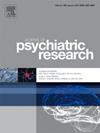多动症和肥胖症儿童大脑形态的共同和独特改变:多动症患儿大脑皮层表面积减少,而超重/肥胖症患儿大脑皮层厚度增加。
IF 3.7
2区 医学
Q1 PSYCHIATRY
引用次数: 0
摘要
目的:为了研究多动症和肥胖症儿童大脑结构的共同差异和不同差异,我们对患有和不患有多动症以及超重/肥胖症(OV/OB)的儿童的单一横断面队列中与认知控制和奖赏功能有关的区域的形态进行了研究:参与者包括471名8-12岁患有多动症的儿童(n = 244; 58 OV/OB)和神经典型(NT)对照组儿童(n = 227; 81 OV/OB),他们被归类为健康体重(HW; BMI %ile 5th to Results):ADHD患者与NT患者相比,表面积普遍较低,包括前扣带回皮层(ACC)、背外侧前额叶皮层(dlPFC)、内侧(m)前额叶皮层和初级运动皮层(M1)。相反,OV/OB 与 HW 相比,ACC、dlPFC、眶额皮质 (OFC)、mPFC 和辅助运动皮质 (SMC) 的皮质厚度普遍较低。此外,ACC和OFC也存在ADHD × OV/OB的相互作用,ADHD + OV/OB组的ACC体积最小,NT + OV/OB组的OFC表面积最大。皮层下体积在不同组间没有差异:我们的研究结果揭示了与多动症和超重相关的大脑皮层形态的不同改变,多动症患者的大脑皮层表面积减少,而超重/肥胖症患者的大脑皮层厚度减少。此外,研究结果还证明,ADHD × OV/OB 对认知和动机不可或缺的大脑区域具有综合影响。我们的研究结果支持对发育中前扣带回形态的共同和独特的 ADHD 和 OV/OB 相关差异的原因和相关因素进行进一步研究。本文章由计算机程序翻译,如有差异,请以英文原文为准。
Shared and distinct alterations in brain morphology in children with ADHD and obesity: Reduced cortical surface area in ADHD and thickness in overweight/obesity
Objective
To investigate shared versus distinct differences in brain structure among children with ADHD and obesity, we examined the morphology of regions implicated in cognitive control and reward function in a single cross-sectional cohort of children with and without ADHD and overweight/obesity (OV/OB).
Method
Participants included 471 children ages 8–12 years with ADHD (n = 244; 58 OV/OB) and neurotypical (NT) controls (n = 227; 81 OV/OB) classified as healthy-weight (HW; BMI %ile 5th to <85th) vs. having OV/OB (BMI %ile≥85th). Structural MRI was performed to obtain measures of cortical and subcortical morphology and compared across ADHD × BMI groups.
Results
Surface area was generally lower in ADHD vs. NT including in anterior cingulate cortex (ACC), dorsolateral prefrontal cortex (dlPFC), medial (m)PFC, and primary motor (M1) cortex. In contrast, cortical thickness was generally lower in OV/OB vs. HW for ACC, dlPFC, orbitofrontal cortex (OFC), mPFC, and supplementary motor cortex (SMC). Furthermore, ADHD × OV/OB interactions were observed for the ACC and OFC, with the lowest ACC volume in the ADHD + OV/OB group and the highest OFC surface area in the NT + OV/OB group. Subcortical volumes did not differ between groups.
Conclusions
Our findings reveal distinct alterations in cortical morphology in association with ADHD and overweight, with cortical surface area reduced in ADHD vs. thickness reduced in OV/OB. Additionally, the findings provide evidence of combined effects of ADHD × OV/OB in brain regions integral to cognition and motivation. Our results support further investigation of causes and correlates of shared and distinct ADHD- and OV/OB-associated differences in developing frontocingulate morphology.
求助全文
通过发布文献求助,成功后即可免费获取论文全文。
去求助
来源期刊

Journal of psychiatric research
医学-精神病学
CiteScore
7.30
自引率
2.10%
发文量
622
审稿时长
130 days
期刊介绍:
Founded in 1961 to report on the latest work in psychiatry and cognate disciplines, the Journal of Psychiatric Research is dedicated to innovative and timely studies of four important areas of research:
(1) clinical studies of all disciplines relating to psychiatric illness, as well as normal human behaviour, including biochemical, physiological, genetic, environmental, social, psychological and epidemiological factors;
(2) basic studies pertaining to psychiatry in such fields as neuropsychopharmacology, neuroendocrinology, electrophysiology, genetics, experimental psychology and epidemiology;
(3) the growing application of clinical laboratory techniques in psychiatry, including imagery and spectroscopy of the brain, molecular biology and computer sciences;
 求助内容:
求助内容: 应助结果提醒方式:
应助结果提醒方式:


